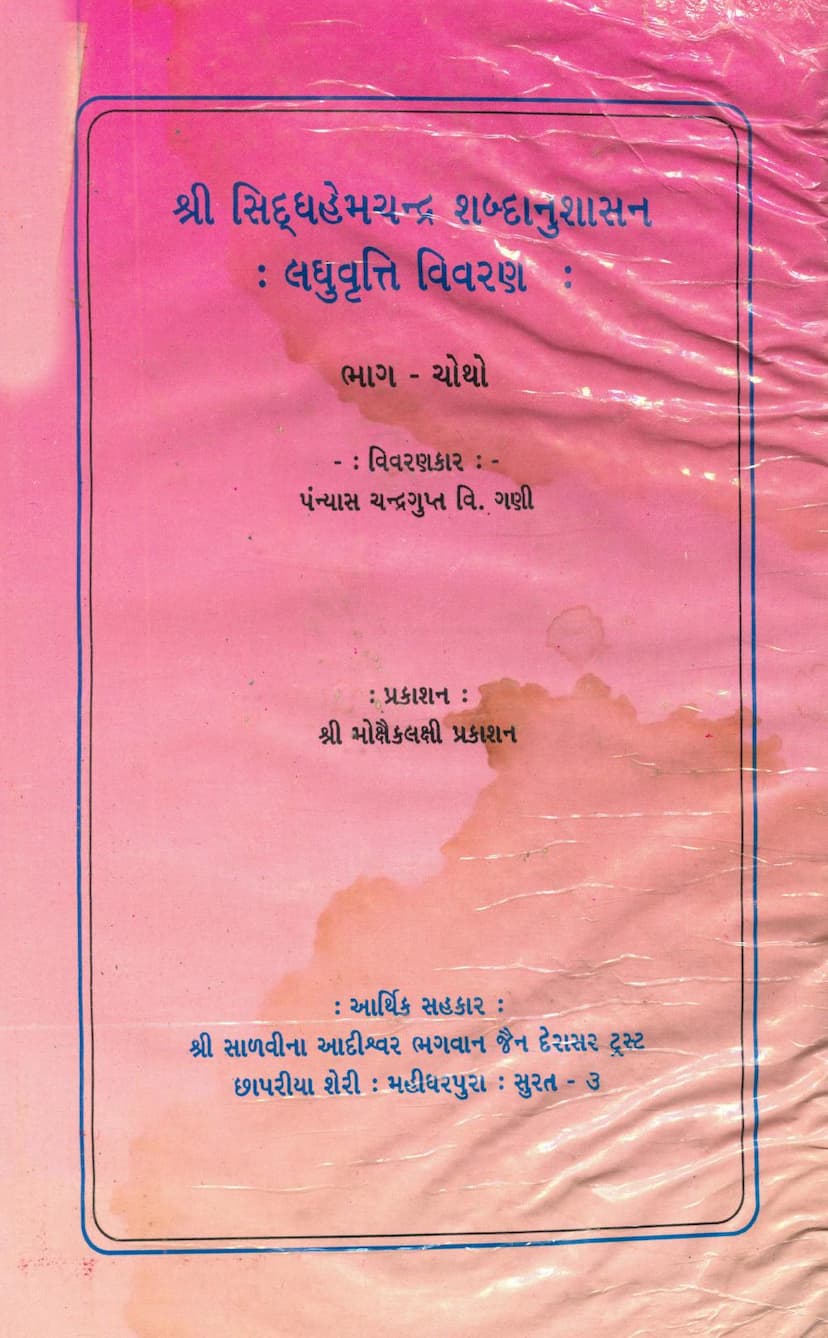Siddhhemchandra Shabdanushasan Laghuvrutti Vivran Part 04
Added to library: September 2, 2025

Summary
Here's a comprehensive summary of the provided Jain text, "Siddhhemchandra Shabdanushasan Laghuvrutti Vivran Part 04," based on the given pages:
Title: Siddhhemchandra Shabdanushasan Laghuvrutti Vivran, Part 4 Author: Pannas Chandragupta V. Gani (Disciple of Acharya Shri Vimal Amaragupta Suri M.S., who was a disciple of Acharya Shri V. Ramchandra Suri Maharaj) Publisher: Shri Moksha-kalakshi Prakashan Financial Support: Shri Salvinan Adishwar Bhagwan Jain Derasar Trust, Chhaperiya Sheri, Mahidharpura, Surat - 3
Overall Purpose: This book is the fourth part of a detailed commentary (Vivarana) on the "Siddhhemchandra Shabdanushasan," a renowned grammar text by Acharya Hemchandracharya, known as the "Kilikala Sarvajna." The commentary aims to explain the intricacies of Sanskrit grammar as presented in the original text, likely focusing on specific sections or chapters related to verb conjugation, noun declension, and other grammatical rules. The target audience is likely students and scholars of Jainism and Sanskrit grammar.
Key Content and Structure (Based on the provided pages):
The provided pages primarily cover a significant portion of the grammatical rules, focusing on verb roots (Dhatu) and their conjugations in various tenses and moods. The commentary systematically explains the application of specific sutras (grammatical aphorisms) from the Shabdanushasan.
Chapter and Section Focus (Inferred from the pages):
- Third Adhyaya (Chapter): The pages predominantly fall within the third chapter of the Shabdanushasan, which likely deals with verb formations and conjugations.
- Third Pada (Section): The commentary seems to be in the third section of the third chapter.
- Specific Sutras and Concepts Explained: The text systematically introduces and explains numerous sutras, each detailing a specific grammatical transformation or rule. These sutras are numbered according to their position in the Shabdanushasan (e.g., 3.3.1, 3.3.2, etc.).
- Dhatu Sangya (Root Designation): Sutras related to designating verb roots are explained, defining what constitutes a "Dhatu."
- Pratyaya Vidhana (Affixation Rules): The commentary details the various affixes (pratyayas) that are added to verb roots, including those for different tenses (like "Vartamana" - present tense, "Paroksha" - past tense), moods (like "Ashir-ling" - optative, "Hyastani" - imperfect), and aspects.
- Sangya (Designations): The text explains the concept of "Sangya" (grammatical designation) applied to various affixes, such as "Shit" (ending in 'it'), "Saptami" (seventh), "Panchami" (fifth), "Hyastani" (imperfect), "Adyatani" (present), "Paroksha" (past), "Ashir" (optative), and "Shvasthani" (future).
- Root Transformations: The commentary meticulously explains how verb roots undergo changes (like "Guna" - vowel augmentation, "Vrddhi" - vowel strengthening, "It" - deletion of 'i', "Niyoga" - assimilation, "Dvitva" - doubling) based on specific sutras and the affixes applied.
- Atmanepada and Parasmaipada: The text distinguishes between verbs that take Atmanepada (middle voice) and Parasmaipada (active voice) endings and explains the rules governing their usage.
- Specific Verb Examples: The commentary provides numerous examples of verb formations, showing how the sutras are applied to create specific verb forms (e.g., "kṛṇoti," "bhavati," "bhavet," "bhavatu," "abhavat," "gacchati," "paśyati," "pacati," "budhyate," "vasati").
- Contextual Explanations: The author often clarifies the meaning of the roots, the intended meaning of the sutras, and the purpose of specific rules, sometimes contrasting the correct usage with potential incorrect applications.
- Root Categories and Rules: Various sutras address specific categories of roots or specific contexts where rules apply or don't apply (e.g., the rule concerning "Pradi" - prefixes).
- The concept of "Kriya" (Action): The text delves into the philosophical understanding of "Kriya," defining it as a collection of primary and secondary actions or processes, and explaining how verb roots represent these actions.
- Analysis of Causative and Desiderative Verbs: Some explanations touch upon how certain sutras lead to the formation of causative verbs ("Prayojak Karta") and desiderative verbs ("Iccharthaka").
Commentary Style: The commentary appears to be in the style of detailed grammatical exegesis. It breaks down the formation of words step-by-step, referencing the original sutras and explaining the changes that occur to the root and the affixes. The language used is formal and technical, typical of Sanskrit grammatical treatises.
Notable Features:
- Systematic Approach: The commentary follows the structure of the Shabdanushasan, explaining sutras in sequence.
- Detailed Explanations: Each sutra is not just stated but elaborated upon with grammatical reasoning and examples.
- Emphasis on Nuances: The author highlights subtle points and exceptions to rules, demonstrating a deep understanding of the subject.
- Jain Scholarly Tradition: The work is presented within the Jain educational framework, with dedications and acknowledgments reflecting this tradition. The mention of "Kilikala Sarvajna Shri Hemchandracharya" signifies reverence for the original author.
In essence, Part 4 of this commentary is a rigorous academic exploration of Sanskrit verb morphology and syntax, crucial for understanding the grammatical framework laid out by Acharya Hemchandracharya.